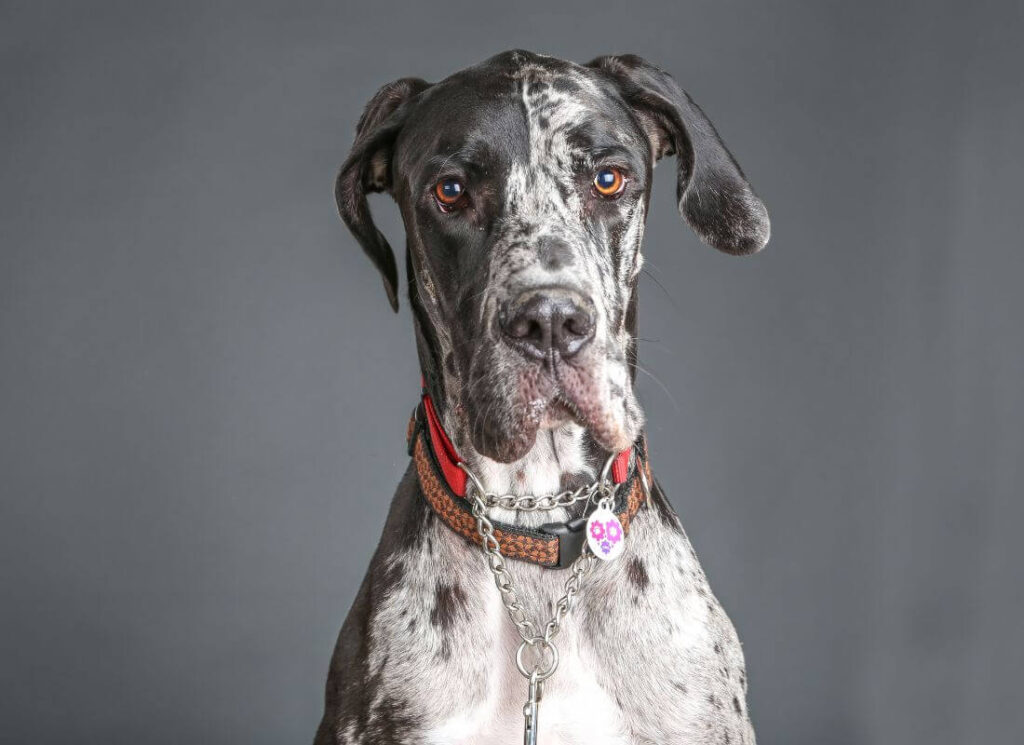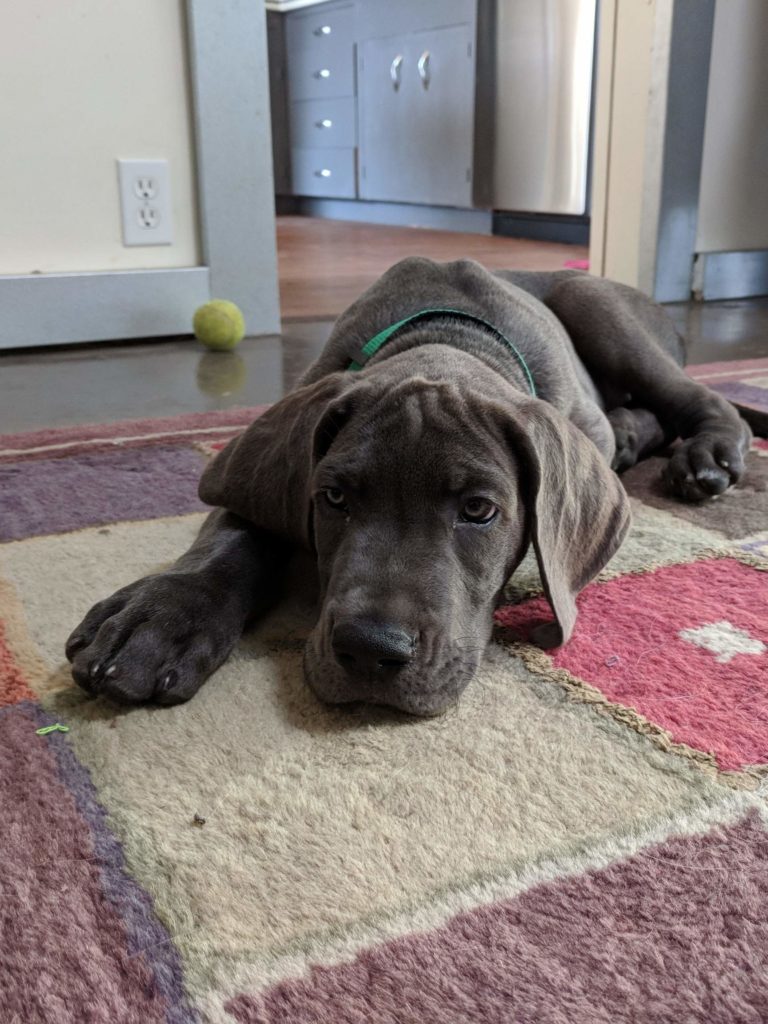When a dog is rude, aggressive, snappy, or out of control, we are taught that this is a sign of dominance in our dogs. Great Dane dominance training aims to address it by helping the owner establish ‘rank’ as the pack leader.
What if I were to tell you that the concept of ‘dominance’ in domesticated dogs is deeply flawed?
To be clear, dominance or “alpha” theory is actually seen by professionals as a potentially harmful ‘woo’ theory with no scientific basis.
What is Great Dane Dominance Training, and is it still relevant? I’m going to answer these questions today!
Note the concept of ‘dominance’ in dog training is SO ingrained and was so popular that information like this can elicit some defensive reactions, especially if you are working with a trainer that still utilizes this ideology. We understand this, but also believe that education is power.

What is Great Dane Dominance Training?
Dominance and alpha theory are the idea that our pet dogs are essentially jockeying for a position at the ‘head of the pack’, and that a lack of alpha-style leadership is why they are aggressive, fearful, rude, or poorly behaved.
The belief is that by relieving the dog of its ‘alpha’ status, it will be calmer, more balanced and less likely to run through doors, pull, jump, bark, hump, resource guard or react poorly towards children, people and other dogs.
Seems logical, right?
The original concept of alpha theory as it relates to pet dogs was originally presented following some questionable studies of a few very frustrated and confused captive wolves.
Captive wolves behave very differently from wild wolves, so it is especially interesting that people are so committed to this concept. The latest research indicates that wild wolves do not fight for alpha status, and their packs are developed as family units with the mother and father as the natural, benevolent leaders.
The original scientist behind these flawed studies of captive wolves, David Mech, has since completely retracted his original captive-wolf findings.
The concept of the ‘alpha dog’ and domesticated pets as we know it is both deeply flawed and not accepted by modern science.
Interesting fact: Some researchers speculate that the original false assumptions about alpha and dominance in other species (such as deer and primates) were driven largely by patriarchal views! Because men (who often held ‘leadership’ positions in the household at a time when women were considered subordinates) were often the people studying animal behavior, their own beliefs biased their observations of the animals they were watching.
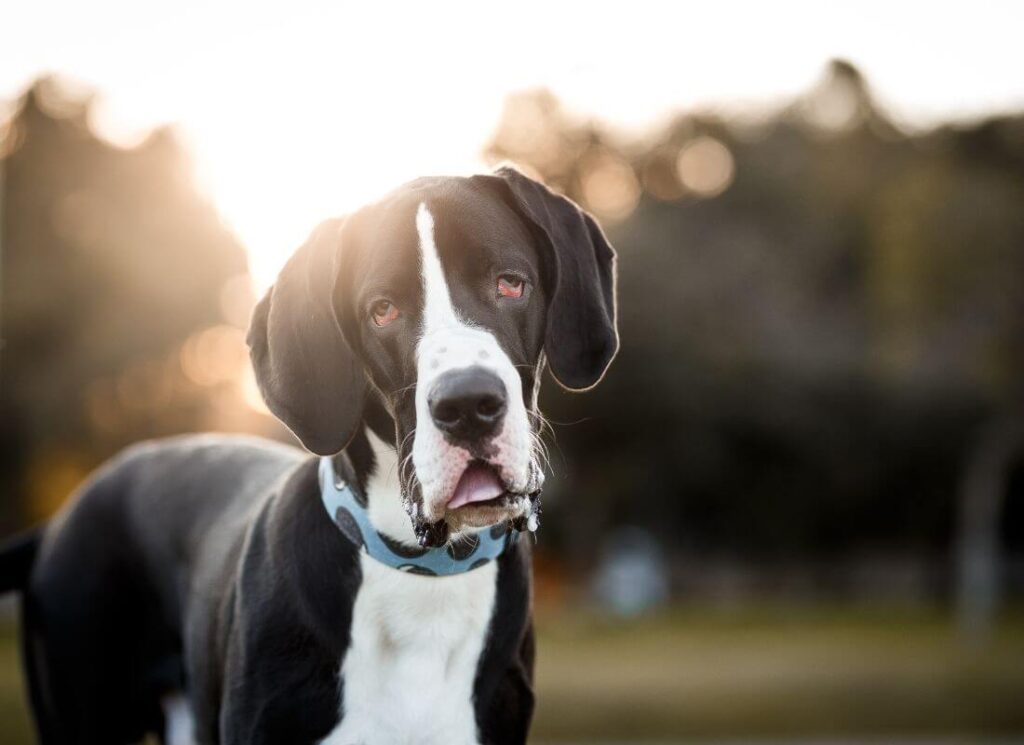
How to be the Alpha to a Great Dane
Believers of the alpha/dominance theory will say that it’s important to ‘be the alpha’.
So, what does ‘being the alpha’ mean? Typically, it involves training that looks like this:
- Maintaining an authoritative demeanor
- Intimidation/power plays
- Jabbing, tapping, biting or kicking (aggression)
- Saying ‘Psssst’ and other sharp interruptions
- Eating first and walking through doors first
- Never allowing the dogs head or body to be in a higher position
- Alpha rolls (pinning the dog down)
- Extended down-stay positions
- Structured walks facing forward, no talking, social or environmental interaction, often in a ‘pack’
This kind of training is, in our opinion, 99% nonsense. Most of it is harmless, some of it can help with structure and boundaries, much of it is unfair and confusing to the dog, and NONE of it actually gives you ‘alpha’ status.
In multi-dog homes, some people even believe that the ‘snappy’ or super confident one is the ‘dominant’ or ‘alpha’ dog and that it should be fed and pet first so the other dogs recognize its ‘position’ in the pack.
Pack walks have become a popular way to showcase ‘control’ of a large pack of dogs, but note that while interesting and impressive to see, walking face-forward on hard pavement and ignoring interesting things is not actually a ‘natural’ activity for a dog, even in a ‘pack’.

Alpha Dog Logic
Even if our house dogs were always trying to become the ‘top dog’ and leader of the house, do these behaviors below (commonly seen as ‘dominance’ or ‘alpha’) truly exemplify a quality, benevolent, mature leader that can maintain the health and well being of a pack:
- Stealing, running away, ignoring commands
- Humping, pinning, neck biting and other rude, immature and out of control social behaviors
- Lack of basic polite social skills and the ability to de-escalate, rather than cause conflict
- Over-excitement and difficulty relaxing
- Anxious behavior (destruction, barking)
- Snapping & growling
- Aggression towards children & people
- Aggression towards dogs
- Guarding food, toys, water and other resources from others in the ‘pack
Many dogs that are labeled as ‘Dominant’ or that exhibit ‘alpha’ behavior are actually immature, under-socialized, untrained, anxious, fearful and have poor social skills.
Do you have a dominant Great Dane that is showing aggressive behavior? Read our blog post on aggression to learn more about Great Dane behaviour.
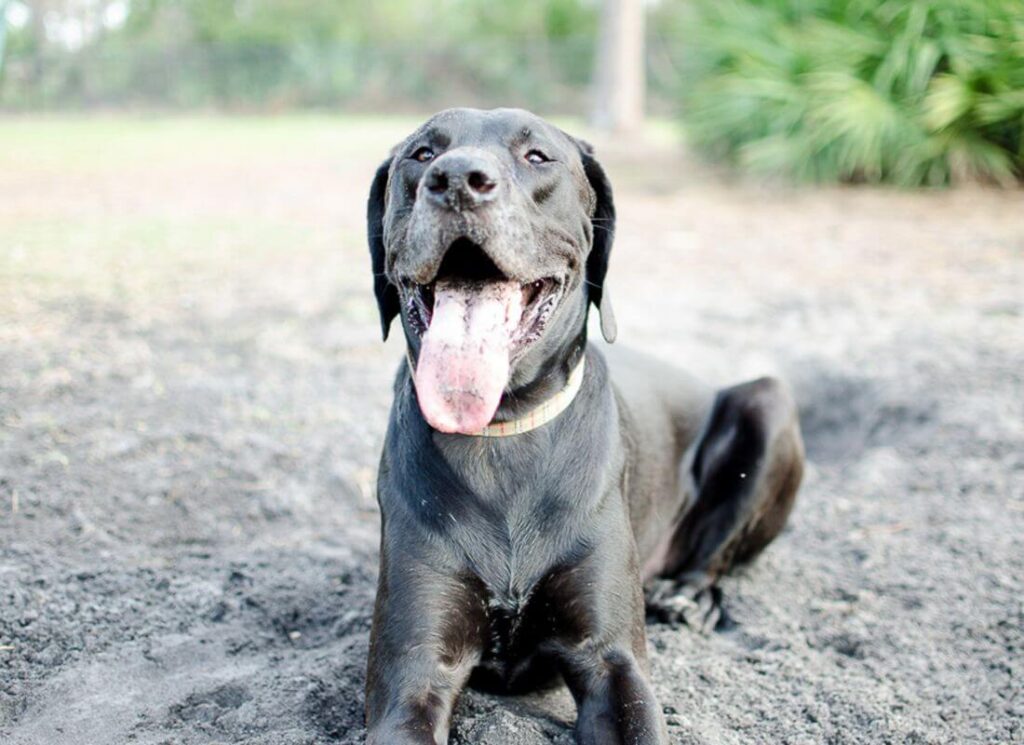
Common Bad Behavior in Great Danes
Barking – Barking is a symptom of anxiety, stress, boredom, habit and genetics. A dog that is over-excited or anxious is not a dog that is ‘dominant’ or ‘protective’.
Resource Guarding – Resource guarding is a natural behavior where dogs will protect something that they see as important. It has everything to do with fear, genetics and past experiences. Truth? If somebody tried to take MY ice cream cone from me, I’d snap too. That doesn’t mean it’s acceptable behavior, but it does give us a much better idea of how to prevent and treat it.
Nipping – Dogs that bare teeth and even go so far as to nip towards dogs, strangers and children are not doing so to establish themselves as some kind of leader or alpha. They are doing it because they are afraid and often because earlier warning signals (stiff body, hackles, growls, avoidance) were either ignored or punished.
This is not to be confused with puppy biting, another natural behavior where puppies learn to control their jaws…not control you.
Pulling & Walking Ahead – dogs that pull have learned somewhere along the way that pulling WORKS. Humans are slow and boring, pulling fixes that problem. Pulling and walking ahead are signs that a dog needs more mental enrichment, training, and positive relationship building (a desire to engage with you as the handler)…not that they are trying to be the boss.
Destruction – dogs that destroy things are most often bored, anxious, frustrated and immature. They don’t do this out of spite, and it’s definitely not a play to be the alpha. Lack of appropriate mental and physical exercise paired with poor management skills (crates, gates, and keeping things put away) often define this behavior.
Not Listening – Dogs that don’t listen often have ‘selective’ hearing because they don’t have a strong, positive relationship with their owner, need more repetitions in their training, haven’t been properly trained/taught how to do something, have been punished and are avoiding the situation, or are over-excited or anxious about the environment. Again, the root causes have very little to do with ‘alpha’ behavior and dominance.
As a matter of fact, punitive, punishment-based ‘alpha’ dominance dog training can be the exact reason that a dog ‘stops listening’ and ‘has no respect’.
Who respects or listens to a harsh authoritative figure? I don’t. I check out, get myself out of the situation, or shut down. Just like a dog would.
Humping – Humping is a sign of overstimulation and anxiety. There is nothing about the immature, out of control behavior of ‘humping’ that tells the humpee (is that even a word?) ‘hey, I’m the boss okay?’. This would be similar to believing that the child who eats glue is the ‘alpha’ kindergartener in a classroom.
Aggression – Leash aggression is especially common (dogs that act like fools on a leash, but fine with other dogs when off). This happens because a dog feels trapped on a leash, there is a lot of tension in the neck when they lunge/pull or are corrected, and they cannot express the normal body language. Off-leash aggression is also driven by fear, past experiences, genetics, and otherwise.
Aggressive dogs are NOT ‘alpha’ or ‘dominant’, they are more likely fearful, insecure, have poor genetics, and/or have poor social skills.
Did you know that according to the written breed standard, Great Danes are not actually supposed to be fearful, timid, or aggressive?
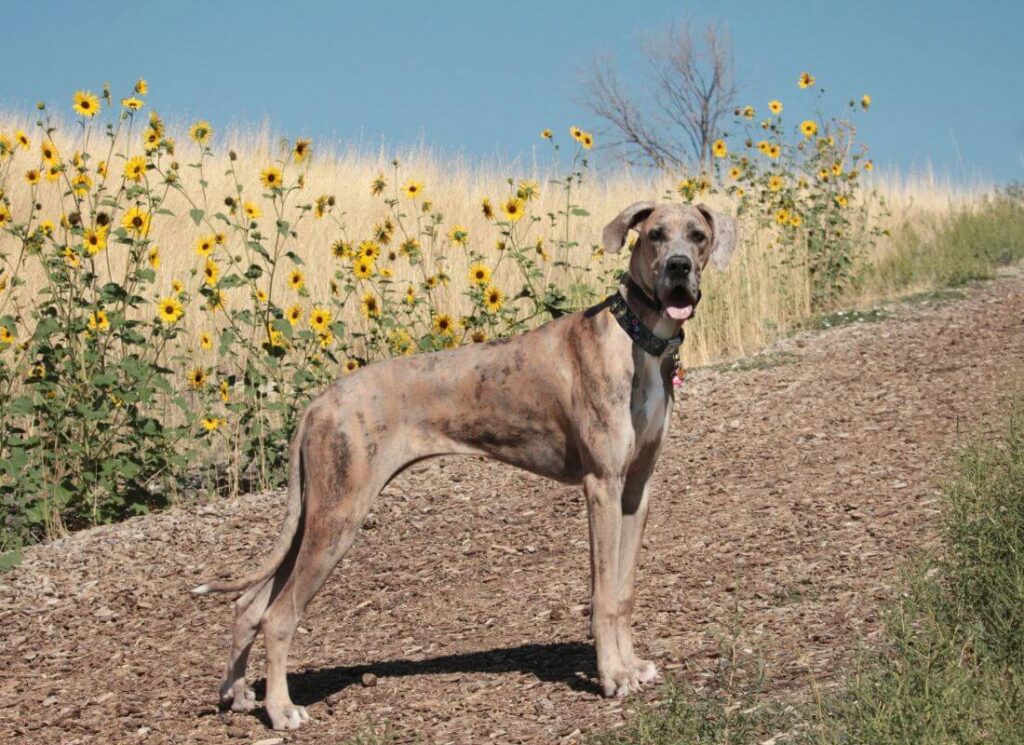
Yes, Leadership in Dog Training Still Matters
This is not all to say that dogs don’t need leadership. It’s important to understand when you are learning how to control a Great Dane that they DO need us to take the reins! They need our guidance, respect, time, and understanding.
Dogs also need training and lots of socialization. No dispute there, as a matter of fact, it’s incredibly important! (If you have a new puppy, we highly recommend you grab a copy of our Great Dane Socialization guide):
There is just no logical sense at all in meeting aggressive, anxious, frustrated, immature behavior with aggressive, frustrated, anxious, and punitive training methods.
Pinning/alpha rolls and other scary, forceful physical corrections are known to increase aggression and anxiety.
Dog training is not meant to be a power struggle. To view it as such is to literally miss the point.
We owe it to our dogs to not boil everything down to ‘dominance’.
Try this instead:
- Find a highly qualified, modern trainer to show you how to use management (crates, gates, muzzles, elevated cots) and fair, appropriate corrections to prevent and stop poor behavior.
- Learn how to teach basic impulse control (wait at doors, leave it, drop it). Susan Garrett ‘It’s Yer Choice’ on Youtube is a great place to start, as well as flirt pole training. Again, this is actual training, not ‘being more dominant’.
- Make sure your dog is receiving plenty of mental and physical enrichment. Most dogs are actually bored, and boredom can drive anxiety, frustration, destruction and ‘out of control’ behavioral situations. A few toys and a short walk are not enough. Take a training or trick class, learn scent work, consider sports such as rally obedience, dock diving and conformation.
- Use modern E-Collars to communicate with your dog and give them amazing off-leash freedom.
- Make it a point to learn one new trick or obedience basic every week. Use positive reinforcement.
- Work with a balanced trainer and learn how to apply corrections thoughtfully and with appropriate timing to strengthen known behaviors.
- If you have a dog that is leash aggressive or aggressive towards children, dogs or people, seek out the help of a highly qualified balanced trainer ASAP.
- Learn how to read and understand canine body language. What is often seen as ‘calm submission’ may actually be a dog that is fearful and shutting down. Learn the difference between ‘shut down’ and ‘knows how to comfortably calm/soothe/chill’, or ‘dominant’ vs. ‘anxious and over-threshold’.
- Recognize when professional help is needed, and that includes visiting a veterinarian and/or veterinary behaviorist to rule out medical causes.
Don’t put a ‘dominance’ or ‘dog psychology’ blanket on dogs that are in pain or have physical, hormonal, or neurological deficits that can be treated.

Reality Television is not the best place to get dog training and behavior advice.
Reality dog training shows and armchair dog trainers have driven these misguided ideas about alpha, dominance and pack theory.
It’s fun to watch a ‘dog whisperer’ magically transform an out of control ‘dominant’ dog into a calm, submissive pet in 20 minutes. This kind of television is engaging and believable.
Yes, the energy you use with your dog matters, but nothing will replace actually training your dog and developing a positive relationship based on trust, benevolent leadership and guidance.
It’s not actually that difficult to intimidate a dog into appearing ‘fixed’ for a 20 minute prime TV slot, and fluff it up with fascinating ‘dog psychology’ so you don’t see that the dog is actually incredibly stressed.
Don’t fall for showmanship. It’s the oldest trick in the book!
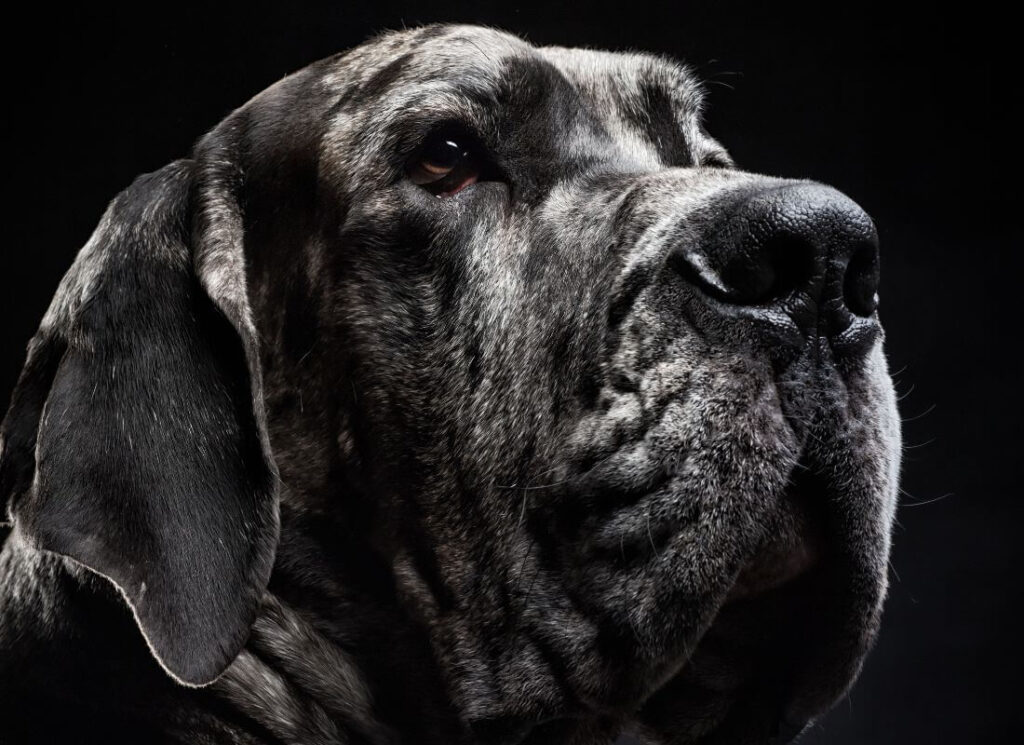
Give Your Dog a Job!
One thing that the dog whisperer does get correct, however? Dogs NEED much more physical and mental enrichment than we tend to give them.
Many behavior problems are solved when you put the time into providing appropriate enrichment & training.
Recognize and understand the true, studied root cause of their behaviors (not dominance but rather fear, confusion, boredom, anxiety or pain) and start there.
Provide your dog with plenty of games, enriching activities, sports, and consistency. A dog is never too old to learn new positive behaviors.
Remember, you already control their food choices, where they sleep, when they get to go out or take a walk or eat dinner, and their day to day access to enrichment and activity.
How much more ‘alpha’ do you really need to be?
